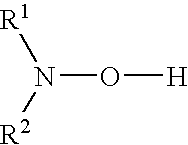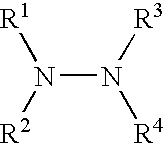Liquid additive for intergrinding cement
a technology of liquid additive and cement, which is applied in the field of compositions and methods for reducing hexavalent chromium in cement compositions, can solve the problems of lower chromium-reducing efficiency of stannous sulfate when used as a liquid, and achieve the effects of reducing hexavalent chromium (crvi), reducing liquid dosage, and reducing dosage ra
- Summary
- Abstract
- Description
- Claims
- Application Information
AI Technical Summary
Benefits of technology
Problems solved by technology
Method used
Image
Examples
example i
[0054]Tin sulfate and tin chloride, in both solid and liquid (e.g., aqueous solution) forms, were tested by intergrinding with them with Portland cement in a laboratory ball mill, and then pore water is obtained from the cement sample thus made to ascertain chromium levels.
[0055]The proportions of materials in the laboratory prepared cement are as follows: 95.3% clinker, 2.8% gypsum, and 1.9% plaster. The grinds were prepared at ambient temperature. The tin sulfate and tin chloride were added in the various dosages shown in Table I below. The dosage for the active stannous tin portion is also given in Table I.
[0056]Soluble ppm chromium (measured as chromate) is given for the cold grind as prepared, as well a portion of the grind that was heat treated at 180° C. for 2 hrs. The purpose of heat treating the grind is to determine the relative resistance of the chromium (“Cr”) reducing agent to ambient oxidation, and, hence, its effectiveness after cement storage.
[0057]
TABLE IColdHeatGri...
example ii
[0064]For comparison, a similar test was done on a different cement interblended (post-grinding) with iron II sulfate. Dosages of 1000–3000 ppm of FeSO4*7H2O lose effectiveness after heating. A dosage of 5000 ppm is required for sustained effectiveness. Dosages of 3000–5000 ppm are typically used to maintain effectiveness after storage. Data is shown in Table II.
[0065]
TABLE IIUK Type I OPCAdded Iron IINo heating180 C. for 2 hrsSulfate heptahydrateMeasuredmeasuredppmCr (VI) ppmCr (VI) ppm 09.810.2 10000.59.630000.03.450000 1.0
example iii
Co-additives
[0066]Efficiency of stannous tin for chromium reduction can be further enhanced by addition of a co-additive to the tin chloride solution. Examples of such co-additives are other reducing agents, such as L-ascorbic acid, which is ineffective in the reduction of chromium in cementitious systems by itself.
[0067]Table III shows a performance comparison of a first solution comprising tin chloride (62%) and water (38%), and a second solution comprising tin chloride (58%), ascorbate (6.1%), and water (35.9%).
[0068]
TABLE IIIColdHeatGrindTreatedAdditiveSn 2+ppmPpmChromate reducing Additive(Ppm)(ppm)CrCrNone——89Stannous chloride powder 422657Stannous chloride powder171107 62% stannous chloride solution 69225862% stannous chloride solution28593562% stannous chloride solution571186 Tin chloride / Ascorbic acid solution 852657Tin chloride / Ascorbic acid solution1715225Tin chloride / Ascorbic acid solution28587
[0069]Both additives were interground into a Portland cement prepared in a labo...
PUM
| Property | Measurement | Unit |
|---|---|---|
| temperatures | aaaaa | aaaaa |
| temperatures | aaaaa | aaaaa |
| temperature | aaaaa | aaaaa |
Abstract
Description
Claims
Application Information
 Login to View More
Login to View More - R&D
- Intellectual Property
- Life Sciences
- Materials
- Tech Scout
- Unparalleled Data Quality
- Higher Quality Content
- 60% Fewer Hallucinations
Browse by: Latest US Patents, China's latest patents, Technical Efficacy Thesaurus, Application Domain, Technology Topic, Popular Technical Reports.
© 2025 PatSnap. All rights reserved.Legal|Privacy policy|Modern Slavery Act Transparency Statement|Sitemap|About US| Contact US: help@patsnap.com


